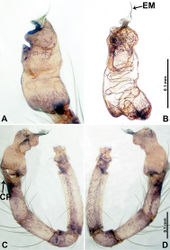Psiloderces bolang
| Notice: | This page is derived from the original publication listed below, whose author(s) should always be credited. Further contributors may edit and improve the content of this page and, consequently, need to be credited as well (see page history). Any assessment of factual correctness requires a careful review of the original article as well as of subsequent contributions.
If you are uncertain whether your planned contribution is correct or not, we suggest that you use the associated discussion page instead of editing the page directly. This page should be cited as follows (rationale):
Citation formats to copy and paste
BibTeX: @article{Chang2020ZooKeys902, RIS/ Endnote: TY - JOUR Wikipedia/ Citizendium: <ref name="Chang2020ZooKeys902">{{Citation See also the citation download page at the journal. |
Ordo: Araneae
Familia: Psilodercidae
Genus: Psiloderces
Name
Psiloderces bolang Li & Chang sp. nov. – Wikispecies link – ZooBank link – Pensoft Profile
Types
Holotype: ♂ (IZCAS), Indonesia, Sulawesi, mountain Palopo, 2°57.6000'S, 120°6.0'E, 509 m, 3.IX.2017, H. Liu & Z. Chen. Paratype: 1♀ (IZCAS), same data as holotype.
Etymology
The species name is a noun in apposition derived from the Chinese pinyin “bōlàng” (wave) and refers to the unique undulated base of the bulb which resembles a wave pattern.
Diagnosis
Males of P. bolang sp. nov. resemble those of P. torajanus by the trilobate base of the bulb and indented ventrally but can be distinguished by the undivided bulb (vs. bulb distinctly divided into two parts (proximal and distal); figs 8, 9 in Deeleman-Reinhold 1995[1]), the bulb with a crooked periphery and rounded tip (vs. bulb with smooth periphery and pointed tip), the length of cymbial protrusion is at least half the width of the bulb (vs. length of cymbial protrusion narrower than the width of the bulb); females of both species resemble looped spermathecae but can be distinguished by rippled spermathecae (vs. smooth elliptical spermathecae).
Description
Male (Holotype). Total length 1.49; carapace 0.47 long, 0.60 wide; abdomen 1.02 long, 0.65 wide. Carapace round and brown, with 3 longitudinal dark brown bands, median band half length the carapace, lateral bands 3 times wider than median band (Fig. 22C). Chelicerae brown, promargin with lamina bearing 2 triangular extensions (Fig. 29E). Clypeus dark brown. Endites dark brown. Labium dark brown delimiting pair of indistinct light brown circular dots. Sternum dark brown, delimiting light brown patch medially. Abdomen elongated, dorsum with dark brown stripes, antero-ventrally with elliptical patch, posterior part with pair of light brown longitudinal lines laterally. Legs uniformly brown; measurements: I 7.73 (2.00, 0.20, 2.40, 2.13, 1.00), II 5.50 (1.30, 0.20, 1.70, 1.50, 0.80), III 5.34 (1.09, 0.16, 1.71, 1.75, 0.63), IV missing. Palp (Fig. 23A–D): femur slender, 3 times longer than patella; patella not swollen; tibia 2 times shorter than femur; cymbium almost as long and wide as tibia, protrusion darkens distally; bulb pale brown, undulate basally and at the margins, pyriform with embolus located anteriorly, with indentation ventrally; embolus laminar and gradually tapering (Fig. 23B). Female (Paratype). General features and coloration similar to those of male (Fig. 22D, E). Measurements: total length 1.30; carapace 0.50 long, 0.60 wide; abdomen 0.80 long, 0.55 wide. Leg measurements: I 4.52 (1.00, 0.16, 1.71, 1.02, 0.63), II missing, III 3.12 (0.80, 0.13, 0.88, 0.81, 0.50), IV 4.60 (1.20, 0.20, 1.40, 1.10, 0.70). Endogyne (Fig. 22A): spermathecae looped transverse anteriorly, rippled posteriorly (Fig. 22A).
Distribution
Known only from the type locality (Fig. 30).
Original Description
- Chang, W; Li, S; 2020: Fourteen new species of the spider genus Psiloderces Simon, 1892 from Southeast Asia (Araneae, Psilodercidae) ZooKeys, 902: 61-105. doi
Images
|
Other References
- ↑ Deeleman-Reinhold C (1995) The Ochyroceratidae of the Indo-Pacific region (Araneae).The Raffles Bulletin of Zoology, supplement2: 1–103.



